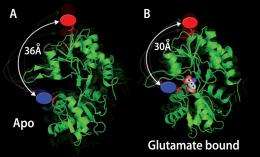Researchers get a grip on nervous system's receptors

A digital signal processing technique long used by statisticians to analyze data is helping Houston scientists understand the roots of memory and learning, Alzheimer's and Parkinson's diseases and stroke.
Researchers at Rice University and the University of Texas Health Science Center at Houston (UTHealth) reported today in the journal Nature Chemical Biology that single molecule fluorescence resonance energy transfer (FRET) techniques combined with wavelet transforms have given them a new view of the AMPA receptor, a glutamate receptor and a primary mediator of fast signal transmission in the central nervous system.
Scientists have long thought these receptor proteins, which bind to glutamate to activate the flow of ions through the nervous system, are more than simple "on-off" switches. A "cleft" in the AMPA protein that looks and acts like a C-clamp and that binds the neurotransmitter glutamate may, in reality, serve functions at positions between fully open (off) and fully closed (on).
"In the old days, the binding was thought to be like a Venus flytrap," said Christy Landes, a Norman Hackerman-Welch Young Investigator Assistant Professor of Chemistry at Rice and lead author of the new paper. "The trap sat there waiting for something to come into the cleft. A neurotransmitter would come in and -- oops! -- it snapped shut on the molecule it was binding to, the gate opened up and ions would flow. We have all sorts of high-quality X-ray crystallography studies to show us what the snapped-open and snapped-shut cleft looks like."
But X-ray images likely show the protein in its most stable -- not necessarily its most active -- conformation, she said. Spectroscopy also has its limits: If half the proteins in an assay are open and half are shut, the measured average is 50 percent, a useless representation of what's really going on.
The truth, Landes said, is that the clefts of AMPA receptors are constantly opening and closing, exploring their space for neurotransmitters. "We know these proteins are super dynamic whether glutamate is present or not," she said. "And we need to look at one protein at a time to avoid averaging."
But seeing single protein molecules go through the motions is well beyond the capability of standard optical tools. That led the researchers to employ a unique combination of technologies. Vasanthi Jayaraman, an associate professor in UTHealth's Department of Biochemistry and Molecular Biology who studies chemical signaling, started the process when she used the binding domain of the AMPA receptor and attached fluorescent dyes to the points of the cleft in a way that would not affect their natural function.
Single-molecule FRET allowed Landes and her team to detect the photons emitted by the dyes. "These experiments had to be done in a box inside a box inside a box in a dark room," she said. "In a short period of measurement, we might be counting 10 photons."
The trick, she said, was to excite only one dye, which would in turn activate the other. "The amount of light that comes out of the dyes has a direct relationship to the distance between the dyes," Landes said. "You excite one, you measure both, and the relative amount of light that comes out of the one you're not exciting depends on how close they are."
Detecting very small changes in the distance between the two points over a period of time required calculations involving wavelets, a tool Rice mathematicians helped develop in the '70s and '80s. (Another recent paper by Landes and Taylor on their wavelet optimization method appears here.)
Wavelets allowed the researchers to increase the resolution of FRET results by reducing shot noise -- distortion at a particular frequency -- from the data. It also allowed them to limit measurements to a distinct time span -- say, 100 milliseconds -- during which the AMPA receptor would explore a range of conformations. They identified four distinct conformations in an AMPA receptor bound to a GluA2 agonist (which triggers the receptor response). Other experiments that involved agonist-free AMPA or AMPA bound to mutated glutamate showed an even floppier receptor.
Knowing how cleft positions match up with the function is valuable, said Jayaraman, who hopes to extend the technique to other signaling proteins with the ultimate goal of designing drugs to manipulate proteins implicated in neurological diseases.
"It was a beautiful combination," she said of the experiments. "We had done a lot of work on this protein and figured out the basic things. What was lacking was this one critical aspect. Being able to collaborate with a physical chemist (Landes) who had the tools allowed us to get details about this protein we wouldn't have seen otherwise."
"Physical chemistry, for all of its existence, amounts to coming up with new tricks to be able to calculate things that nature would not have us calculate," Landes said. "I think our true contribution is to be able to analyze this noisy data to get to what's underneath."
More information: www.nature.com/nchembio/journa … bs/nchembio.523.html
Provided by Rice University
















